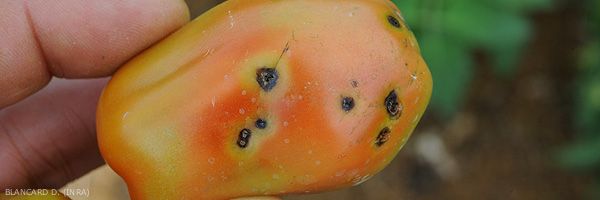
- classification : Bacteria, Proteobacteria, Gammaproteobacteria, Xanthomonadales, Xanthomonadaceae
- synonyme : Xanthomonas campestris pv. vesicatoria (Doidge 1920) Dye 1978
- English name: bacterial spot
The Xanthomonas spp. responsible for bacterial mange are particularly damaging on tomatoes and even more so on peppers. This disease is rife on all continents, almost everywhere where tomatoes are grown. It is particularly serious in the open field, in tropical, subtropical and temperate zones, where climatic conditions are hot and humid. In temperate regions, especially in Europe, it does not seem to affect crops under cover, whether cold or heated. In France, it mainly affects varieties intended for industry in the summer.
These Xanthomonas were reclassified in 2004 into four species according to phenotypic and genetic criteria: X. euvesicatoria (ex group A), X. vesicatoria (ex group B), X. perforans (ex group C) and X. gardneri (ex group D), two of which ( X. euvesicatoria and X. perforans ) are phylogenetically similar. The strains of the four groups have an almost worldwide distribution. Only strains of X. vesicatoria (group B) are believed to be rampant in France.
In addition, the bacterium X. campestris pv. raphani , generally attacking several cruciferous species, is also aggressive on tomatoes and peppers, with very similar symptoms.
X. euvesicatoria and X. gardneri are pathogenic on tomatoes, peppers and peppers and cause epidemics in these species. X. vesicatoria and X. perforans are only affected on tomato. On solanes, X. campestris pv. raphani was only detected from field symptoms in tomatoes (Canada, USA, Russia and Zambia).
This Gram bacterium - was first described on tomato in South Africa at the beginning of the 20th century. For approximately 70 years, she was considered a single microorganism, with the existence of races.
species and races Xanthomonas associated with bacterial scab of tomato
| Species |
Other names found in the literature Groups described |
Associated breeds | |
| Xanthomonas euvesicatoria |
Xanthomonas axonopodis pv. vesicatoria |
Xanthomonas campestris pv. vesicatoria Group A |
T1 |
| Xanthomonas vesicatoria |
Xanthomonas campestris pv. vesicatoria Group B |
T2 | |
| Xanthomonas perforans |
Xanthomonas axonopodis pv. vesicatoria |
Xanthomonas campestris pv. vesicatoria Group C |
T2, T3 and T4 |
| Xanthomonas gardneri |
Xanthomonas campestris pv. vesicatoria Group D |
T2 | |
As you can see, the situation with Xanthomonas spp. on Solanaceae is quite complex and constantly evolving. It will therefore be advisable to consider with some caution the information mentioned in this sheet which does not distinguish between the 4 species now known. Not yet knowing clearly if these have fundamentally different biological properties, we will use, for the sake of simplicity, the synonymy X. campestris pv. vesicatoria to talk about these bacteria.
Dominique BLANCARD (INRA), Olivier PRUVOST (CIRAD). 06-01-2012





